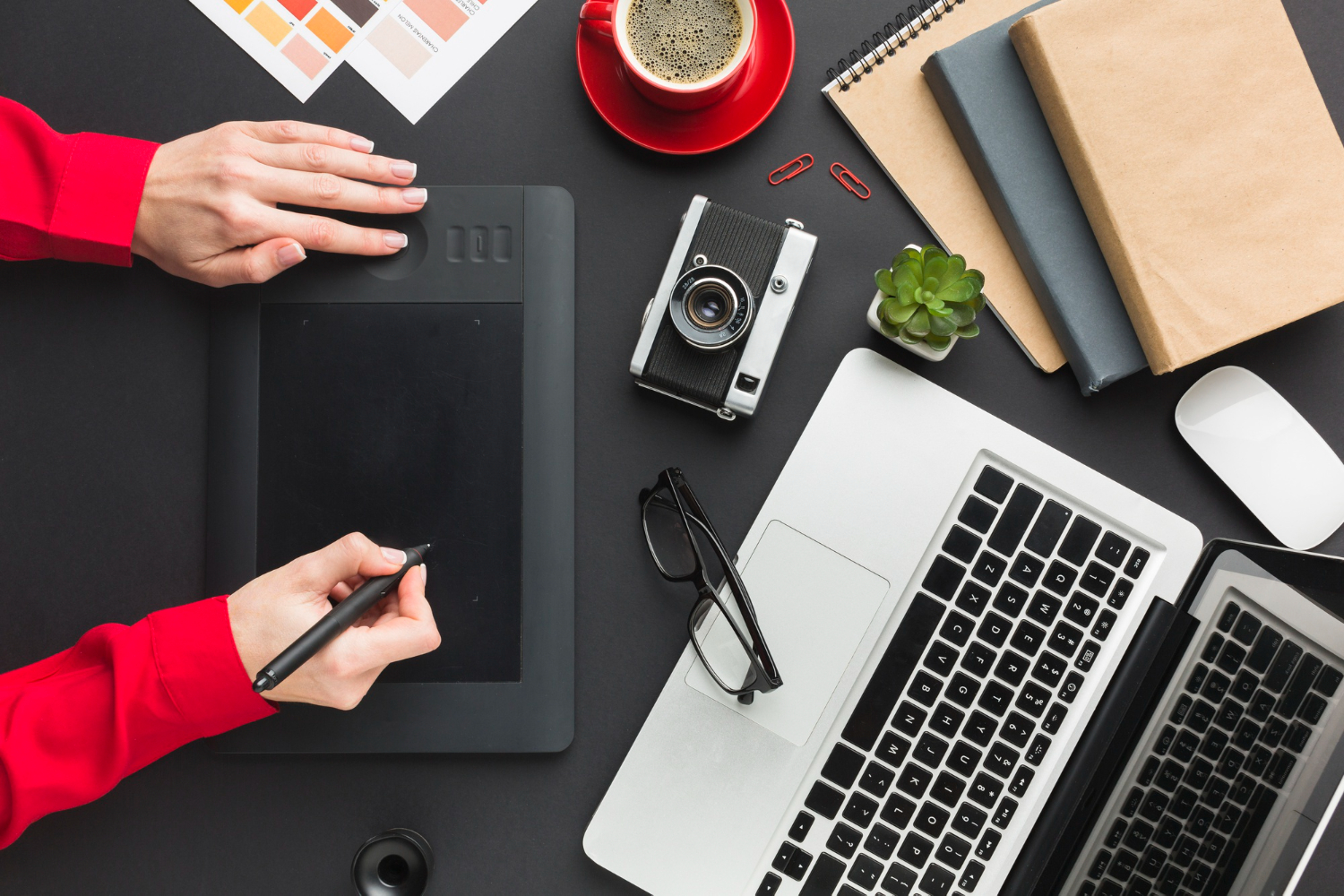Are you wondering what qualifications a junior product designer needs to have? Discover all the information you require with this comprehensive career guide.
What does a junior product designer do?
An essential component of the product design team is a junior product designer. Whether it’s a tangible product like shoes, backpacks, or coffee makers, or a digital one like an app or website, they add to the overall success of the product they’re working on.
A junior product designer may collaborate closely with just one or two other designers in a small startup. They could be one of numerous junior designers in a larger organization, with a lot of mid-level and senior product designers above them. Everything is dependent on the team’s composition and size.
Junior product designers should anticipate being involved in every step of the design process, no matter where they work. In order to satisfy target customers and achieve corporate objectives, they assist in the creation of new goods and the enhancement of current ones.
Junior product designers might help with the following tasks or handle them alone:
Researching competitors and the market.
carrying out user research through the use of questionnaires, card sorting, and interviews.
Developing personalities that embody the intended consumer base of the product.
Generating ideas for new features and product concepts.
Making prototypes, wireframes, and sketches.
Forming the product’s user interface (UI), or its interactive and visual aspects (this is specific to digital products alone)
Conducting usability tests and making design decisions based on the information received.
Junior product designers engage closely with important stakeholders from various departments inside the company, such as developers, manufacturers, senior designers, and product managers.
To put it briefly, that is the role. Let’s now examine what a junior product designer‘s typical day would entail.

An average junior product designer’s day
Consider yourself a junior product designer at TutorFoundry, a digital firm.
Through an app called TutorFoundry, high school students can find tutors in a variety of areas. Pupils can schedule online tutoring sessions or locate nearby instructors for in-person tutoring. The product design team is concentrating on enhancing the product and fine-tuning the user experience because the app is still in its early stages of development.
This is an example of a typical workday for a junior product designer at TutorFoundry.
Morning
09:30 am – 10:00 am: Prepare for the day ahead
After arriving at work, you get coffee from the kitchen and take a seat at your desk. Asana, your team’s project management platform, is one of the things you check to get an overview of your current duties as you get ready for the day. You also browse through your emails and Slack conversations.
10:00 am – 10:30 am: Team meeting
We have a brief team meeting for product design to officially start the day. You gather together to talk about ongoing tasks, exchange information, and decide on the day’s top priorities.
10:30 am – 12.30 pm: User research analysis
Going over the information gathered from a recent round of user interviews is your main responsibility for the day. For the next two hours, you read through the transcripts, categorizing the quotes that encapsulate intriguing ideas or concepts into categories and applying codes or labels to them.
Afternoon
1:45 pm – 3 pm: Continue with user research analysis
You carry on with your study of the user interviews after lunch. It is not unusual for this kind of qualitative research analysis to take up most of the day because it often takes much longer than for quantitative data. Our guide contains information on the distinctions between qualitative and quantitative data.
3:20 pm – 4:15 pm: Prepare your research presentation
The following stage after finishing your study analysis is to put all of the important findings into a brief presentation. In the morning meeting tomorrow, you’ll present this to the product manager and senior product designer. The insights you gain from it will help guide a future brainstorming session.
4:15 pm – 5.30 pm: Create wireframes
It’s time to shift gears! Some problems with the TutorFoundry search results page were found during earlier user tests. It should be possible for users to look for tutors according to their specific needs and find qualified professionals in the search results with ease.
But with the existing layout, customers are faced with an excessive amount of information on a single page, which makes it challenging to navigate and select pertinent matches. It is now your responsibility to rework the results page such that it is uncluttered, clear, and easy to scan. You start by drawing the new layout’s basic wireframes.
Evening
5:30 pm – 6:20 pm: Prepare for upcoming ideation session
At the end of the week, you and the other members of the product design team have an ideation session arranged. The objective is to identify viable remedies for the issues raised, and this will be based on the information you gathered from the user interviews.
You spend the rest of the workday considering possible solutions you may discuss at the team ideation session and studying rivals to see how they handle these specific difficulties.
6:20 pm – 6.45 pm: Wrap-up
The day is over! And that was such a productive day. Since you don’t have any appointments tomorrow, you opt to work from home. You grab your laptop and go.
What skills and qualifications do junior product designers need?
Research, analysis, and practical design work are all part of the diverse role that junior product designers enjoy. The position is highly collaborative and requires both technical and artistic skills. Junior product designers therefore need a broad range of abilities, including both hard and soft capabilities.
What skills do employers look for when hiring junior product designers?
We searched through active job postings to compile a list of the essential competencies that recruiters want in junior product designers. Our research indicates that the following are the most crucial competencies and attributes for a junior product designer:
- The capacity to comprehend end users’ demands and create with them in mind is known as a user-centric attitude.
- being at ease with data interpretation and applying it to well-informed design decisions
- Problem-solving and creative thinking
- strong familiarity with the process of designing products and the capacity to perform useful design tasks like wireframing and prototyping
- a thorough knowledge of the best practices and guiding principles of UX & UI design
- Good communication abilities
In addition, proactive behavior, an eagerness to learn, the capacity for both giving and receiving constructive criticism, and an acute attention to detail are all displayed by successful junior product designers.
What qualifications and experience do you need to land a junior product design role?
Since junior product designer is an entry-level position, the majority of businesses won’t ask you to have a lot of prior work experience. Still, a few or all of the following will help you get hired for positions involving junior product design:
- A pertinent degree, such as an industrial or product design bachelor’s degree, or a certification earned via an online course or product design boot camp
- Practical experience gained via project work done for a product design course or from a design internship
- Familiarity with widely used design tools (more about those in the next part)
Employers would also consider experience and transferable abilities. Hiring managers may view your experience working in a position that necessitates a lot of cooperation and communication, for instance, as a plus.
What tools do junior product designers need to know?
Throughout the entire process of designing a product, product designers depend on specific tools. Employers will seek candidates who are proficient in the following tools, or who at least have some knowledge of them, when employing junior product designers:
- Figma
- The Adobe Creative Suite, which consists mostly of InDesign and Illustrator
- Tools for managing projects, like Trello or Asana
- Google Meet, Google Docs, Google Sheets, and Google Slides are examples of Google Workspace tools.
- Tools for user research and analytics like Maze and Hotjar
- Tools for collaboration and documentation like Mural, Miro, and Notion
- You should be conversant with 3D CAD software and rendering and modelling tools like Solidworks, Rhino, KeyShot, and Fusion360 if you’re concentrating on industrial product design and/or physical products.
Keep in mind that you can be hired for a junior product design position without having to be an expert in every one of these areas. Above all, you must be able to show that you have a rudimentary understanding of how to use design tools. You can pick up on the specific tool stack that each organisation has on the job, in addition to the industry standard tools.
See the top 10 tools that are essential for any product designer to get a deeper look at tools and software.
How much do junior product designers earn?
Let us move on to the topic of pay. How much money as a junior product designer can you anticipate making if you land a job?
The following represents the average salary for junior product designers across several locations:
- According to data from Glassdoor, Indeed, and PayScale, the average compensation for a junior product designer in the US is approximately $72,000.
- According to Glassdoor data, the typical compensation for a junior product designer in the UK is approximately £32,000.
- According to Glassdoor data, the typical junior product designer pay in Canada is approximately $57,000.
- According to Glassdoor data, junior product designers in Germany typically make approximately €44,000 annually.
- According to Glassdoor data, the average yearly compensation for a junior product designer in Australia is approximately $74,500.
Remember that pay varies according on years of experience, industry, location, and specific job title. Use websites like Glassdoor, Indeed, and PayScale to look up average earnings in your area for a more precise comparison.
Are you curious about how your earning potential rises with experience? View our comprehensive information on product designer salaries.
How to become a junior product designer (step-by-step)
You now have a good understanding of the qualifications that hiring managers seek in junior product designers. How then do you put yourself up for these kinds of positions?
How to work as a junior product designer is provided here.

1. Learn essential product design skills
Acquiring basic abilities in product design is the first step.
A product design course or bootcamp is one of the best options if you’re brand-new to the industry. You’ll learn all the most crucial ideas and subjects in a sensible order with the help of a professional curriculum and the knowledgeable advice of tutors and mentors, guaranteeing that you graduate with a well-rounded and current set of product design skills.
See our comparison of the top 10 product design courses (including both free and paid choices) for assistance in selecting a pertinent course.
2. Gain practical experience
You want to do more than just study product design in your pursuit of becoming a junior product designer. Additionally, you must acquire pertinent practical skills and use your newly acquired information in real-world situations.
Probably one of the most difficult parts of entering the field is this. Getting experience that is relevant to your field of work before you actually start working can be challenging, but it’s not impossible.
When selecting a course on product design, make sure the curriculum involves project work and hands-on activities. You’ll be able to use this practical experience to your advantage when applying for junior product design positions.
Consider an internship in product design as well. Naturally, not everyone will be able to pursue this, but if you have the time and financial means, internships can be a fantastic way to get your first full-time employment in product design.
3. Build your product design portfolio
Applying for jobs as a junior product designer will require you to submit concrete evidence of your abilities. It is imperative that you expand your product design portfolio in tandem with your skill set development.
A personal website showcasing your completed projects is called a product design portfolio. An “About” page or section, connections to social media accounts and contact information, and—above all—project case studies that showcase your work are usually included.
Your position in the project, the user problem you set out to solve, the procedures you followed, the results you achieved, and the quantifiable impact of your effort should all be described in each case study.
4. Grow your network
It’s been estimated that 60% of employment are obtained through networking rather than online job boards. Focus on expanding your network and establishing useful contacts in the industry if you want to improve your chances of getting hired as a junior product designer.
Right now, LinkedIn is the most popular website for online networking, so start there. It’s time to create a LinkedIn profile if you don’t already have one. If you’re already on LinkedIn, start interacting with product design experts by joining groups that are pertinent to you.
Your product design education may also present networking chances for you. Developing a strong network of product design experts and students, including possibilities for feedback, knowledge sharing, and insider access to job openings, is a major goal of many institutes and bootcamps.
5. Emphasize your transferable skills and experience
Employers won’t expect you to be an expert in product design with a tonne of industry experience if you work as a junior product designer because this is an entry-level position. On the other hand, they will be searching for abilities that you can apply to the position.
Junior product designers frequently need to have transferable skills in communication, problem-solving, attention to detail, time management, flexibility, teamwork, research abilities, and a customer-centric approach.
You’ve probably developed at least some of these talents, regardless of your experience, so make sure to highlight them in your cover letter, portfolio, and resume as well as throughout the interview process.
Using the STAR method is an excellent way to identify transferable skills. Situation, Task, Action, and Result is referred to as STAR.
Key takeaways and next steps
We’ve covered the requirements and experience needed to become a junior product designer in this piece, along with what it’s like to work in the industry.
In the end, it’s critical to remember that the majority of employers consider the position of junior product designer to be entry-level. As a result, you are not required to meet every single condition stated in the job advertisement. You can apply with confidence for junior product designer opportunities as long as you can show that you have the essential transferable skills, a love for the subject, and basic product design abilities.
Junior product designer FAQ
What is a junior product designer?
A professional at the beginning level of the design area is a junior product designer. They play a crucial role in the product design team, helping with activities like usability testing, wireframing and prototyping, and user research. Junior product designers contribute to the creation of both new and improved goods.
How do I get into product design with no experience?
Acquiring basic abilities in product design is the first step. An excellent location to start is with a product design course or bootcamp, which offers an organised method for acquiring the required abilities, resources, and procedures. To showcase your improved abilities, you’ll also need to compile an impressive portfolio of your product designs. If you want product designing and don’t want to learn it then you can contact Omar Technologies for it.
What qualifications do you need to be a product designer?
A bachelor’s degree in product design, industrial design, or a similar discipline may be required by employers. Alternatively, you can increase your chances of getting hired for product design positions by earning a certification in product design through an online course or bootcamp. However, a solid product design portfolio and familiarity with industry tools, principles, and procedures are far more crucial than any degree.
What is the average junior product designer salary?
The average compensation for a junior product designer in the US is roughly $72,000. Senior product designers typically make between $129,000 and $98,000 per year, while mid-level designers may expect to make roughly $98,000. Remember that this is only a baseline and that actual pay will vary based on experience, industry, and geography.
